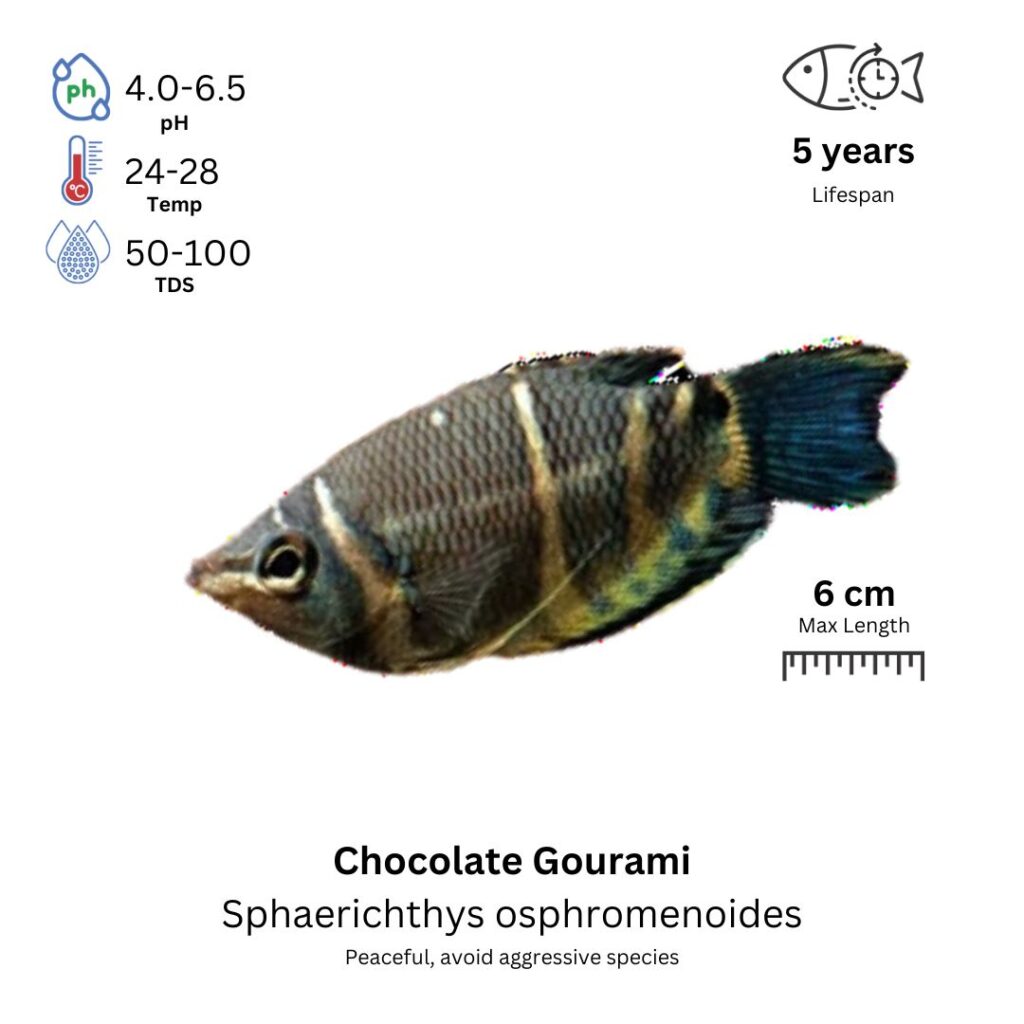Chocolate Gourami
Sphaerichthys osphromoides

Description
The Chocolate Gourami is a small, peaceful, and beautifully colored fish known for its striking chocolate-brown body adorned with light-colored patterns. These patterns can vary, but they generally consist of horizontal or vertical stripes and spots, giving the fish a unique appearance reminiscent of chocolate. The males tend to have brighter, more pronounced coloration, especially during breeding seasons, while females are slightly duller but still visually appealing. Chocolate Gouramis have a round, slightly flattened body shape with long pectoral fins that add to their graceful swimming. These fish are shy, non-aggressive, and do best in well-planted tanks where they can find hiding spots and swim peacefully.
Habitat Origin
Native to the slow-moving, clear waters of Southeast Asia, particularly in the forests and wetlands of Borneo and Sumatra. They are typically found in low-oxygen environments, such as swampy areas with dense vegetation and acidic, soft water. Chocolate Gouramis thrive in habitats that offer plenty of cover and a slow to moderate water flow.
Aquarium
Ideal Number in Aquarium: At least 4-6 individuals, as they are social fish and feel more comfortable in groups.
Favorite Food

Chocolate Gouramis are omnivores, and they will accept a variety of foods. In the wild, they feed on small invertebrates, plant matter, and detritus. In captivity, they can be fed high-quality flake food, micro pellets, live or frozen foods like brine shrimp, daphnia, and bloodworms. They will also appreciate blanched vegetables such as spinach or zucchini. A varied diet helps maintain their health and vibrant coloration.
Behavior:
Chocolate Gouramis are peaceful and shy fish that do well in well-planted aquariums with slow-moving water. They are bottom-dwellers, spending most of their time near the substrate or in plants where they can hide and forage for food. These fish are not aggressive but may become stressed in a tank with fast-moving fish or overly active species. When kept in groups, they display more natural behavior and become more active. They are best suited for aquariums with other calm species that share similar water requirements. Since they prefer slow-moving water, it’s important to avoid strong currents in the tank.
Special Care:
Chocolate Gouramis are sensitive to water quality, so maintaining stable water parameters is essential. They require soft, acidic water, and fluctuations in pH or temperature can stress them. It’s recommended to use a sponge filter or a filtration system with a gentle flow to maintain a calm environment. A well-planted tank with plenty of hiding places is crucial to their well-being. Avoid copper-based medications, as they are toxic to these delicate fish. Regular water changes and good filtration are essential for their health.
Compatibility with Other Fish:
Yes, Chocolate Gouramis are compatible with other peaceful species that thrive in soft, acidic water. They can be housed with small, non-aggressive fish such as tetras, rasboras, and small catfish. It is best to avoid housing them with fast-moving or larger fish that might stress or outcompete them for food. Due to their shy nature, it’s important to keep tankmates that won’t bully or harass them.
Breeding Setup
Using a separate breeding tank is highly recommended for Chocolate Gourami to ensure proper control of water conditions and to protect eggs or fry from being eaten. A 40-liter (10-gallon) aquarium is ideal, providing ample space for the pair and their fry. These fish thrive in soft, acidic water with a pH of 5.5–6.5, temperature between 26°C to 30°C (79°F–86°F), and hardness of 1–5 dGH. A gentle sponge filter is necessary to maintain clean water without disturbing the fish. Add a fine sandy or gravel substrate along with dense planting using Java moss, Anubias, or Hornwort. Keep the lighting low to moderate, as Chocolate Gouramis prefer dim, shaded environments similar to their natural habitat.
Conditioning for Breeding
To prepare Chocolate Gouramis for breeding, provide a rich, varied diet. Include high-quality flakes, live foods like brine shrimp, daphnia, and bloodworms, and frozen foods to meet their nutritional needs. The protein boost helps trigger spawning behavior. Perform weekly water changes of around 25% to maintain excellent water quality, reduce stress, and support reproductive readiness in both males and females.
Spawning Process
Chocolate Gourami spawning typically occurs in the early morning or late evening, when water parameters are ideal. Males initiate courtship by displaying brighter colors and performing gentle swimming dances. This species is a bubble-nest builder: the male constructs a small nest near the surface, often hidden among plants. The female will deposit around 20–40 eggs, which the male fertilizes and gathers into the nest. After spawning, remove the female to prevent any male aggression, as the male assumes full parental care by guarding the nest and fanning the eggs until they hatch.
Fry Care
The eggs hatch in 24–48 hours, after which the fry stay attached to the bubble nest while absorbing their yolk sacs. Once they become free-swimming, start feeding them infusoria, liquid fry food, or tiny live foods like rotifers. As they grow, you can offer baby brine shrimp or finely crushed flakes. Perform small daily water changes (10–15%) and maintain stable water temperature and pH to support healthy fry development. Clean, stable conditions are essential at this delicate stage.
Important Notes
Chocolate Gouramis reach sexual maturity around 6–12 months of age, but it’s best to breed only fully mature, healthy specimens. Males are smaller and more vividly colored, especially during breeding, while females appear rounder when carrying eggs. To maximize breeding success, avoid sudden fluctuations in pH, temperature, or tank conditions, as Chocolate Gouramis are highly sensitive to stress. Keeping their environment calm and consistent is key to successful spawning and fry survival.

